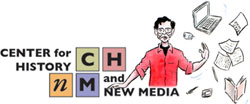- Center for History and New Media
infobox University
name= Center for History and New Media
location= Fairfax, VA
established= 1994
website= [http://chnm.gmu.edu chnm.gmu.edu]The Center for History and New Media (CHNM) at
George Mason University was established byRoy Rosenzweig in 1994 to research and usedigital media andinformation technology in historical research, education, digital tools and resources,digital preservation , and outreach.Digital preservation
Following the
September 11, 2001 attacks , the Center for History and New Media organized the September 11 Digital Archive [http://911digitalarchive.org/] , in partnership with theLibrary of Congress , theCity University of New York , and with funding from theAlfred P. Sloan Foundation. With the September 11 Digital Archive, CHNM utilized electronic media to collect, preserve, and present the past, with a digital repository of material including more than 150,000 first-hand accounts, emails, images, and other digital materials. This project has inspired a new project, the Hurricane Digital Memory Bank [http://hurricanearchive.org] , which is collecting the stories and digital artifacts related to theHurricane Katrina , Rita, and Wilma. CHNM continues to explore methods, tools, and technologies for archiving and preserving information, data, and documents digitally.Educational resources
The Center for History and New Media worked in partnership with the American Social History Project (ASHP) at the City University of New York, to develop an online resource directed at American History teachers, along with online resources about the
French Revolution . More recent projects have focused on developing online educational resources aboutWorld History , and a project on historical thinking, in partnership with theSmithsonian Institution ’sNational Museum of American History . CHNM is also involved with educational outreach with teachers inVirginia school districts.CHNM has also developed a number of online databases and other resources for historians and history teachers, including a listing of 1,200 history departments worldwide, a practical guide to Digital History (a book by Dan Cohen and Roy Rosenzweig that is published in print by University of Pennsylvania Press and available free online [http://chnm.gmu.edu/digitalhistory] ), a collection of essays on history and new media.
oftware resources
Currently available in public beta,
Zotero is a free, open source scholars' extension for theFirefox browser produced by the Center for History and New Media.The Center for History and New Media also distributes a set of free additional digital tools for historians and teachers, including Web Scrapbook, Survey Builder, Scribe (a note taking application designed with historians in mind), Poll Builder, H-Bot (an automated historical fact finder), and Syllabus Finder, which allows you to find and compare syllabi from thousands of universities and colleges on any topic, using the
Google search engine.Scholarship
Projects like Zotero provide tools for historians to research and analyze the past. But will digital media change the nature of scholarly argument, communication, and publication? In order to encourage experimentation in this arena, American Quarterly in collaboration with the American Studies Crossroads Project and CHNM organized an experiment in hypertext publishing [http://chnm.gmu.edu/aq] . Four essays, covering such diverse topics as photos, as legal evidence, the
Spanish-American War in film, early comic strips, andArnold Schwarzenegger , offer contrasting approaches to using digital media for scholarly presentations. Imaging the French Revolution [http://chnm.gmu.edu/revolution/imaging] is another experiment in digital scholarship. In a series of essays, seven scholars analyze forty-two images of crowds and crowd violence in the French Revolution. Offering the most relevant examples and comments from an on-line forum, those same scholars consider issues of interpretation, methodology, and the impact of digital media on scholarship.Finally, Interpreting the
Declaration of Independence by Translation [http://chnm.gmu.edu/declaration] is a roundtable of historians brought together to discuss the translation and reception of the Declaration of Independence in Japan, Mexico, Russia, China, Poland, Italy, Germany, Spain, and Israel. In addition to these reflections, the site includes actual translations of the Declaration into several different languages and "re-translations" back into English to illustrate the effects of translation on how a key historical document has been understood.Public outreach
CHNM has also developed some projects with an explicit focus on broad, public audiences.
Gulag : Many Days, Many Lives [http://gulaghistory.org] , a web-based exhibit funded by NEH and being developed in collaboration with theGulag Museum inPerm, Russia , will provide a multifaceted consideration of the human struggle for survival in the Gulag, the brutal and often lethal Soviet system of forced laborconcentration camp s. For Crossroads of War: Civil War and Homefront in Mid-Atlantic Border Region Crossroads, CHNM will assist in the design, production, and hosting of an online exhibition and archive on theAmerican Civil War in the mid-Atlantic border region for the Catoctin Center for Regional Studies atFrederick Community College .History News Network [http://chnm.gmu.edu/hnn] features articles, placing current events in historical perspective, written by historians of all political persuasions.See also
*
Digital History External links
* [http://chnm.gmu.edu Center for History and New Media]
Wikimedia Foundation. 2010.
